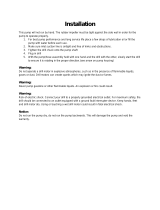
19
MANTA PARTS LIST
PARTS LIST:
Item Description Qty MK p/n
A Assembly, M1 Base, Vacuum 1 n/a
A1 Base, M1 Vacuum 1 155753
A2 Screw, ½-13 x 3 ½ Hex Hd. Cap, Full Thread 4 158284
A3 Gasket, Neoprene 1 154543
A4 Fitting, ¼ MNPT x 3/8 Barb 1 154659
A5 Wheel 6” 2 157434
A6 Screw, 1/2 x 1 3/4 Socket Head Shoulder 2 158390
A7 Washer, ½ SAE Flat 2 150924
A8 Foot, Base Support 2 158389
A9 Screw, 3/8-16 x 2 ¼ Hex Head Cap 2 153529
A10 Washer, 3/8 SAE Flat 2 150923
A11 Nut, 3/8-16 Hex Nylok 2 152505
A12 Stud, ½-13 x 4 Clamping 1 155124
A13 Washer, Plate ¼ x 2 x 2 1 154613
A14 Nut, ½-13 Flange 1 155125
AA Assembly, M1 Base, Anchor 1 n/a
AA1 Base, M1 Anchor 1 155755
AA2 Screw, ½-13 x 3 ½ Hex Hd. Cap, Full Thread 4 158284
AA3 Wheel, Dia. 1 5/8 x 7/8 2 158396
AA4 Sleeve Bearing 2 158458
AA5 Screw, ¼-20 x 2.0, Socket Head Cap 2 158394
AA6 Foot, Base Support 2 158389
AA7 Screw, 3/8-16 x 2 ¼ Hex Head Cap 2 153529
AA8 Washer, 3/8 Flat 2 150923
AA9 Nut, 3/8-16 Hex Nylok 2 152505
AA10 Label, Manta Serial Tag (not shown) 1 157730
AA11 Label, Caution, Safety (not shown) 1 155576
AA12 Label, MK, Adhesive (not shown) 1 157914
D Assembly, Carriage 2 ½” 1 n/a
D1 Body, Carriage 1 155757
D2 Shaft, Gear, Short 1 158348
D3 Bearing 2 137711
D4 Plate, Adjustment 3 157317
D5 Slide, Carriage 8 157318
D6 Screw, 6-32 x 1/2 Flat Head Phillips Machine 8 154448
D7 Screw, 6-32 x 3/8 Flat Head Phillips Machine 8 157521
D8 Nut, 6-32 Nylok Hex 8 157519
D9 Knob, Davies ¼-20 x ¾ 1 151681
D10 Washer, ¼ SAE Flat 1 151915
D11 Back, Carriage 1 157438
D12 Screw, 1/4-20 X 1 Socket Head Cap 4 151049
D13 Screw, ¼-20 x 5/16 Socket Head Set 6 154226
D14 Handle, Carriage 1 157440
D15 Screw, 1/4-20 X ¾ Pan Head Phillips 2 157523
D16 Label, MK USA 2 154334
D17 Screw, 1/4-20 X 1 ¼ Socket Head Cap 4 159336
E Assembly, Control Box, Fixed, Dual Switch 120V 1 158428
E1 Box, Control, Fixed 1 158274
E2 Cover, Control Box, Fixed, Dual Switch 1 158276
E3 Screw, ¼-20 x ¾ Socket Head Cap 2 152587
E4 Washer, ¼ Split Lock 2 152591
E5 Screw, 10-24 x 5/8 Self Tapping (phillips) 6 153681
E6 Ammeter 120V 1 154489























